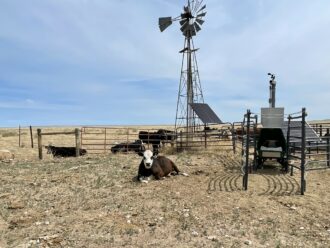As cows digest grasses and other cellulose-rich plants, microbes in their large first stomach – the rumen –break down the feed, releasing the potent greenhouse gas methane as a natural fermentation byproduct. Research is ongoing into seaweed and other additives to traditional forages to reduce methane production, creating low-emission feeds.
But what if you created low-emission cattle as well?
Like a fuel-efficient car, a low-emission beef cow would use fuel – in this case feed – more efficiently, converting it into muscle readily and minimizing methane emissions over the life of the animal.
Animal genetics are complex and genetic selection tools haven’t advanced to that point yet. But research is being done into understanding how genetics effects methane emissions.
Ashley Schilling, a doctoral student with Colorado State University’s AgNext program, is working on a Western SARE-funded project that examines how animal genetics and grazing practices effect both emissions and performance.
“There has been extensive research into the impact feedlot systems have in the environmental footprint of beef cattle, but when we look at a grazing environment we actually don’t know as much about grazing animals,” Schilling explained. “And the majority of a beef animal’s life I spent in a grazing environment.”
Her project compares two sets of genetically distinct steers – one group sourced locally within Colorado, the other imported from Nebraska – in a production environment. Both were grazed at the USDA-ARS Central Plains Experiment Range during the summer grazing season in 2022.
The local steers originate from a similar shortgrass steppe ecosystems as the experiment station, while the Nebraska steers originate from a tall grass prairie ecosystem.
“We were able to measure methane emissions in grams per head per day and weighed the steers every 28 days to calculate the average daily gain,” Schilling said. “Then we calculated methane emissions intensity, or the grams of methane per kilogram of average daily gain.”
What she found was the local steers emitted more methane but they also had a greater average daily weight gain so their overall emissions intensity was significantly lower than the steers from Nebraska.
“So we started thinking about the factors that might have played into that,” she said. “Why were they more efficient?”
This is where things get tricky from a scientific standpoint.
Were the local steers simply eating more? In a feedlot, that would be easier to measure but in a pasture it’s more complex. There are halters being developed to measure bite rate and may in the future provide some data on grazing consumption, but Schilling’s future research will use a titanium dioxide tracer to estimate feed intake.
“Another thing we thought would be interesting to look at is potential microbiome difference between the two groups of cattle,” she said. “Are these local cattle already acclimated and prepared with the right microbes to digest that local forage more efficiently compared to the cattle brought from a different ecosystem? Maybe the microbes in the Nebraska cattle just took a little bit of time to adjust. We don’t know that yet.”
They also don’t know if the emissions intensity difference measured in the pasture will remain consistent when the steers go to a feedlot for finishing the last part of their growth.
But as her Ph.D. and Western SARE research progress, Schilling will be able to answer some of those questions and help Western ranchers and the Colorado State AgNext program reduce the climate impact of raising beef cattle.
“AgNext is a new initiative at CSU and our main mission is to identify and scale innovations that will foster the health of animal agriculture but also the ecosystems in which we produce animal agriculture – while also considering the economic and social impacts of those innovations,” Schilling said. “It’s allowing us to address some of the critical challenges facing animal agriculture.”
Methane emissions will continue to be one of those challenges, and genetic selection may be one element in overcoming it.
“I think as we move forward in this space and talk about genetics, it’s not always going to be about maximizing what we have but optimizing it,” Schilling explained. “When we talk about maximizing, we’re talking about growth, getting bigger. And we know that as animals get bigger, they’re going to eat more and they are going to emit more because as they eat more they ferment more so logically it makes sense they would emit more.”
But by changing the focus to optimizing growth rather than maximizing it, producers benefit by raising more efficient cattle in their individual and unique production environments which should translate into environment benefits from the lower emissions intensity of those animals.
“It’s a way to get more by using less,” Schilling said. “I think optimization will be critical. And we need to remember it is not going to be a silver-bullet approach that overcomes this challenge, but rather a silver-buckshot approach. It won’t be one strategy that will work for everyone producing beef, but rather many different strategies catered uniquely to each producer.”
